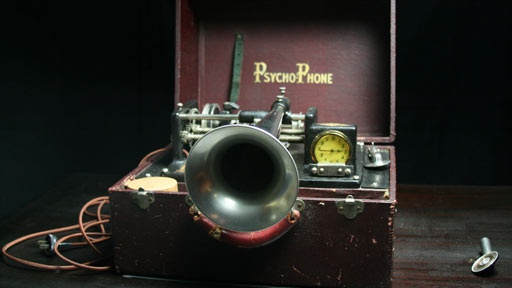Page 2 of 4
Re: cylinder recording motor
Posted: Sun Jun 20, 2021 2:57 am
by VanEpsFan1914
I really doubt this is a clock--I suspect it is more likely some sort of chart recorder, or at least part of one missing the drum & the ink pen.
Re: cylinder recording motor
Posted: Sun Jun 20, 2021 3:20 am
by gramophoneshane
Chart recorder... probably the word I was looking for

There's no doubt this is a Waterbury movement, but just what modifications have been made, and its use is hard to say.
I'd still be interested to know just how the OP came up with the John C Hoyer connection, especially if as I suspect, the lower left arm of movement carries the Waterbury Clock Co makers mark.
I'd have to agree that it isn't clock.
Re: cylinder recording motor
Posted: Sun Jun 20, 2021 7:48 am
by JerryVan
At first I had the thought that it might be a pidgeon racing clock, but those are more sophisticated.
Re: cylinder recording motor
Posted: Sun Jun 20, 2021 8:25 am
by gramophoneshane
It's weird that it has 2 mainsprings, yet doesn't appear to have a regular chime/striker/alarm set-up in the movement, so what does the second spring run, or does it somehow run in tandem with the other?
I never thought about a pigeon clock.
I wonder if there are old Waterbury catalogues online, or if a clock forum member might identify it?
Re: cylinder recording motor
Posted: Sun Jun 20, 2021 9:14 am
by Curt A
It probably isn't a clock, even though it started out as one. It appears that something was attached to the front of the box as evidenced by the holes around the perimeter... but, what? A clock movement is more for accuracy than power, like a phonograph motor, so it couldn't have driven anything that required much power. You can stop a clock movement easily... It must have been a timer for some purpose.
Re: cylinder recording motor
Posted: Mon Jun 21, 2021 6:04 am
by andyive
This is what I have found so far. JOHN C HOYER IS THE NAME ON THE FRONT, AND THERE IS A FAST AND SLOW LEVER AS MENTIONED
This document is to put together all we know from the emails I have received about this clock winder.
From Graces book:
John C. Hoyer
of St. Mary's Works, Eldon Road, Wood Green, London, N
1899 Company established.
Manufacturers of scientific instruments including Dr. A. D. Waller's physiological instruments, digital sphygmographs, photographing boxes, lantern railways, myographs, chloroform apparatus etc., Lippmann's capillary electrometers etc.,
slow and fast clock-driven cylinders for recording, THIS IS THE ITEM
electric signal time clocks, Dr. W. L. Symes' embedding baths and apparatus, all-metal gas regulators, clinical and surgical instruments, engineers' small tools, gas and electric heated soldering irons, "Always Accurate" pocket spring balance for nurses, fishermen, jewellers etc. [1]
As you see there is mention of the fast and slow mechanism, controlled by the small lever on the top
From Wikipedia on Cylinders:-
…In addition to poor states of preservation, the poor impression modern listeners may get of wax cylinders is from their early date, which can compare unfavorably to recordings made even a dozen years later. Other than a single playable example from 1878 (from an experimental phonograph-clock), the oldest playable preserved cylinders are from the year 1888.
This why I assumed that we appear to own an experimental phonograph clock?
Also Attached is the Seth Thomas write up from the America clock journal. THE CLOCKWORK MACHANISM IS SETH THOMAS
From a contact in Germany
There were cylinder phonographs and later disc machines that where used to play messages at night while the subject was sleeping to subconsciously induce positive messages. One of these devices was called a psychophone, if I recall correctly.
So, any and all suggestions welcome
Re: cylinder recording motor
Posted: Mon Jun 21, 2021 10:05 am
by Curt A
Quote from Andyive: "This is what I have found so far. JOHN C HOYER IS THE NAME ON THE FRONT, AND THERE IS A FAST AND SLOW LEVER AS MENTIONED"
It would have been nice in your first post to include pictures that showed this information, instead of leaving us to guess what it could be used for, or how you concluded that John C. Hoyer had anything to do with it.
What it isn't: It is NOT a Psychophone. A Psychophone is a phonograph/quack medical device that played Psycho records when you sleep.
Your device is also NOT related to phonograph cylinder recording. John C. Hoyer's "cylinder recording device" recorded scientific data on rotating "paper cylinders".
What it is: It is the base for a home made Kymograph, which records scientific data on vertical, rotating, paper cylinders - using a clockwork motor to spin the cylinders.

- psychophone.jpg (28.65 KiB) Viewed 684 times
Re: cylinder recording motor
Posted: Mon Jun 21, 2021 11:30 am
by fran604g
Not to get too off-topic or anything, but Tim Fabrizio was involved in a
History Detectives episode aired on PBS many years ago and provided help on the topic of the
Psycho-Phone. Although unfortunately, I can't locate a video on the great wide cyber-world, I did locate an excerpt.
I hope this helps to further clarify what the OP's device
is not.
https://m.sdparanormal.com/page/page/265918.htm
Re: cylinder recording motor
Posted: Mon Jun 21, 2021 12:18 pm
by gramophoneshane
andyive wrote: Mon Jun 21, 2021 6:04 am
Also Attached is the Seth Thomas write up from the America clock journal. THE CLOCKWORK MACHANISM IS SETH THOMAS.
Interesting that Waterbury Clock Co and Seth Thomas Clock Co use identical frames and components in their movements, so both being in Connecticut there must have been a connection there?
Seth Thomas himself died in 1859 but his clock company survived until 2009.
The companies most famous clock is in Grand Central Station.
Re: cylinder recording motor
Posted: Mon Jun 21, 2021 12:37 pm
by JerryVan
I believe Curt has this nailed 100%